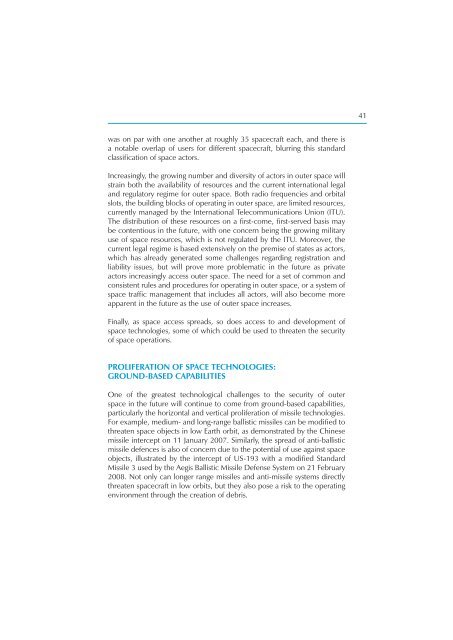Security in Space The Next Generation - UNIDIR
Security in Space The Next Generation - UNIDIR
Security in Space The Next Generation - UNIDIR
You also want an ePaper? Increase the reach of your titles
YUMPU automatically turns print PDFs into web optimized ePapers that Google loves.
was on par with one another at roughly 35 spacecraft each, and there is<br />
a notable overlap of users for different spacecraft, blurr<strong>in</strong>g this standard<br />
classifi cation of space actors.<br />
Increas<strong>in</strong>gly, the grow<strong>in</strong>g number and diversity of actors <strong>in</strong> outer space will<br />
stra<strong>in</strong> both the availability of resources and the current <strong>in</strong>ternational legal<br />
and regulatory regime for outer space. Both radio frequencies and orbital<br />
slots, the build<strong>in</strong>g blocks of operat<strong>in</strong>g <strong>in</strong> outer space, are limited resources,<br />
currently managed by the International Telecommunications Union (ITU).<br />
<strong>The</strong> distribution of these resources on a fi rst-come, fi rst-served basis may<br />
be contentious <strong>in</strong> the future, with one concern be<strong>in</strong>g the grow<strong>in</strong>g military<br />
use of space resources, which is not regulated by the ITU. Moreover, the<br />
current legal regime is based extensively on the premise of states as actors,<br />
which has already generated some challenges regard<strong>in</strong>g registration and<br />
liability issues, but will prove more problematic <strong>in</strong> the future as private<br />
actors <strong>in</strong>creas<strong>in</strong>gly access outer space. <strong>The</strong> need for a set of common and<br />
consistent rules and procedures for operat<strong>in</strong>g <strong>in</strong> outer space, or a system of<br />
space traffi c management that <strong>in</strong>cludes all actors, will also become more<br />
apparent <strong>in</strong> the future as the use of outer space <strong>in</strong>creases.<br />
F<strong>in</strong>ally, as space access spreads, so does access to and development of<br />
space technologies, some of which could be used to threaten the security<br />
of space operations.<br />
PROLIFERATION OF SPACE TECHNOLOGIES:<br />
GROUND-BASED CAPABILITIES<br />
One of the greatest technological challenges to the security of outer<br />
space <strong>in</strong> the future will cont<strong>in</strong>ue to come from ground-based capabilities,<br />
particularly the horizontal and vertical proliferation of missile technologies.<br />
For example, medium- and long-range ballistic missiles can be modifi ed to<br />
threaten space objects <strong>in</strong> low Earth orbit, as demonstrated by the Ch<strong>in</strong>ese<br />
missile <strong>in</strong>tercept on 11 January 2007. Similarly, the spread of anti-ballistic<br />
missile defences is also of concern due to the potential of use aga<strong>in</strong>st space<br />
objects, illustrated by the <strong>in</strong>tercept of US-193 with a modifi ed Standard<br />
Missile 3 used by the Aegis Ballistic Missile Defense System on 21 February<br />
2008. Not only can longer range missiles and anti-missile systems directly<br />
threaten spacecraft <strong>in</strong> low orbits, but they also pose a risk to the operat<strong>in</strong>g<br />
environment through the creation of debris.<br />
41








